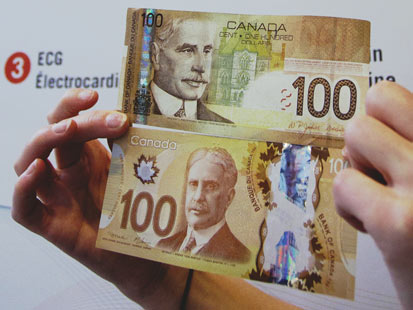Canada Introduces New Plastic Currency
Canada may be permanently swapping paper for plastic, providing its recently-released polymer $100 note is well-received.
The brand new bill was put into circulation starting Nov. 14, with $50 and $20 bills scheduled for 2012 and $10 and $5 bills slotted to come out in 2013.
Polymer currencies, first developed in the 1980s in Australia, have helped countries cut back on counterfeit bills. Australia introduced polymer cash in 1988.
The new bill is equipped with security features that make it very difficult to counterfeit, according to the Bank of Canada’s press release . A transparent maple leaf and a clear portion on the left side of the bill with holographs that change color in the light are designed to foil counterfeiters attempting to create fake notes.

The polymer series costs 19 cents per unit to produce, almost twice the 10 cents needed to make paper bills. But they are more cost-effective in the long run, said Bank of Canada spokesperson Julie Girard. They are recyclable and last two and a half times longer than the older cotton-based model, she said.
The U.S. has tried to cut costs by replacing its dollar bills with $1 coins, but the American public has resisted giving up its greenbacks. The idea of U.S. dollars replaced with plastic bills has not been proposed.
The front of the new Canadian bill features a portrait of Sir Robert Borden, the country’s prime minister from 1911 to 1920. The back is a tribute to Canadian scientific advances, such as the discovery of insulin by Canadian scientist Sir Frederick Banting.
Although many consumers now pay with credit or debit cards, Canadian officials have been quick to point out that half of the country’s transactions are still cash-based. “Reports of the death of cash are greatly exaggerated,” Mark Carney, the governor of the Bank of Canada, said at a press conference.
Girard said the currency department has worked for two years to ready machines that process money, such as ATMs, for the release of the new currency.
The machines have had to make changes to process the polymer model, but ” We’re working really really hard with them to provide them with notes and to give them expertise,” Girard said. “We do everything we can to help them make a smooth transition.”